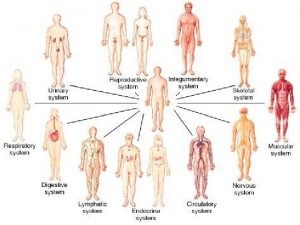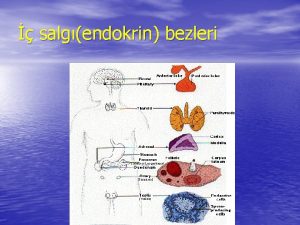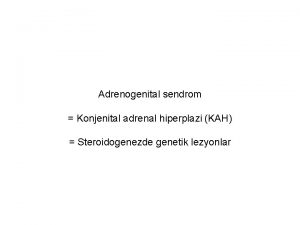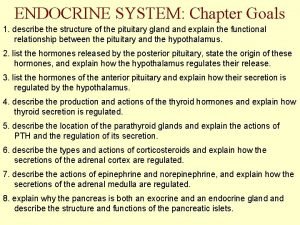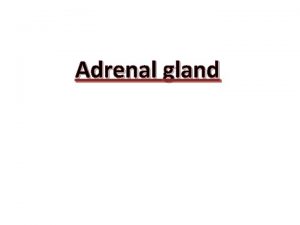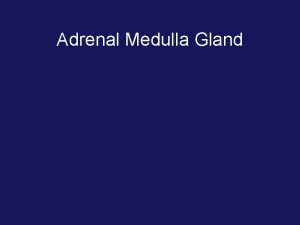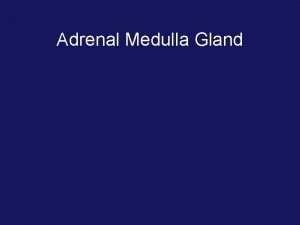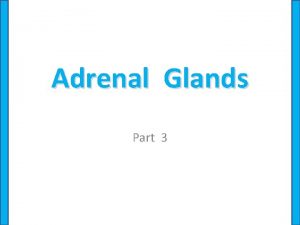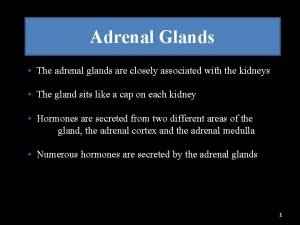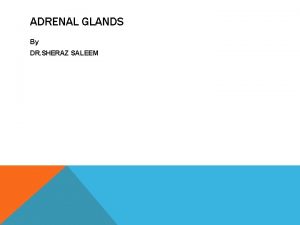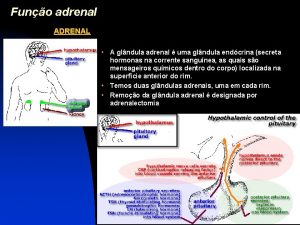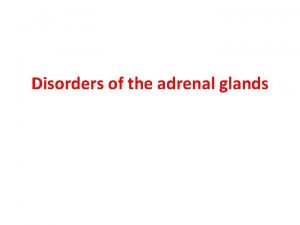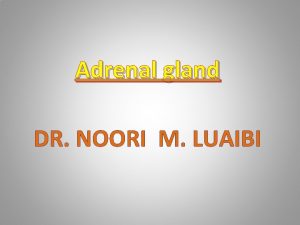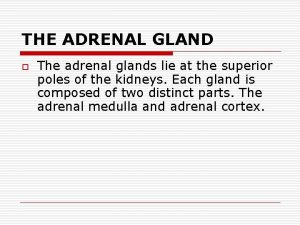Adrenal Glands Introduction to the Adrenal Glands The




















- Slides: 20

Adrenal Glands

Introduction to the Adrenal Glands • The adrenal glands are endocrine glands that produce a variety of hormones. Adrenal hormones include the fight-or-flight hormone adrenaline and the steroid hormone cortisol. • The two adrenal glands are located on both sides of the body, just above the kidneys. • The right adrenal gland (on the left in the figure) is smaller and has a pyramidal shape. • The left adrenal gland (on the right in the figure) is larger and has a half-moon shape. Each of the two adrenal glands is found above a kidney. (By EEOC (cancer. gov) [Public domain], via Wikimedia Commons; Illu adrenal gland. jpg)

Adrenal Glands • Each adrenal gland has two distinct parts, and each part has a different function, although both parts produce hormones. • There is an outer layer, called the adrenal cortex, which produces steroid hormones including cortisol. • There is also an inner layer, called the adrenal medulla, which produces nonsteroid hormones including adrenaline.

• The adrenal cortex, or outer layer of the adrenal gland, is divided, in turn, into three additional layers, called zones (see figure below). Each zone has distinct enzymes that produce different hormones from the common precursor molecule cholesterol, which is a lipid. Adrenal Cortex 1. Zona glomerulosa is the outermost layer of the adrenal cortex. It lies immediately under the outer fibrous capsule that encloses the adrenal gland. 2. Zona fasciculata is the middle layer of the adrenal cortex. It is the largest of the three zones, accounting for nearly 80 percent of the adrenal cortex. 3. Zona reticularis is the innermost layer of the adrenal cortex. It is directly adjacent to the medulla of the adrenal gland.

Adrenal Cortex The adrenal cortex is divided into the three zones shown here. Each zone produces a different type of steroid hormone. This photomicrograph also shows the medulla of the adrenal gland. (By Jpogi [CC 0], via Wikimedia Commons; Adrenal cortex labelled. jpg)

• Hormones produced by the adrenal cortex are called by the general term corticosteroids. Types of Adrenal Cortex Hormones • As steroid hormones, corticosteroids are endocrine hormones that are made of lipids and exert their effects on target cells by crossing the plasma membrane and binding with receptors within the cytoplasm. • A steroid hormone and its receptor form a complex that enters the cell nucleus and affects gene expression. • There are three types of corticosteroids synthesized and secreted by the adrenal cortex. • Each type is produced by a different zone of the adrenal cortex

Mineralocorticoids • Mineralocorticoids are produced in the zona glomerulosa and include the hormone aldosterone. These hormones help control the balance of mineral salts (electrolytes) in the body. In the kidneys, aldosterone increases the reabsorption of sodium ions and the excretion of potassium ions. • Aldosterone also stimulates the retention of sodium ions by cells in the colon and by the sweat glands. The amount of sodium in the body affects the volume of extracellular fluids including the blood and thereby affects blood pressure. In this way, mineralocorticoids help control blood volume and blood pressure.

• Glucocorticoids are produced in the zona fasciculata and include the hormone cortisol, which is released in response to stress and is considered the primary stress hormone. Glucocorticoids help control the rate of metabolism of proteins, fats, and sugars. Glucocorticoids • In general, they increase the level of glucose and fatty acids circulating in the blood. Cells rely primarily on glucose for energy, but they can also use fatty acids for energy as an alternative to glucose. Glucocorticoids are also involved in suppression of the immune system, having a potent anti-inflammatory effect. • In addition, cortisol reduces the production of new bone and decreases the absorption of calcium from the gastrointestinal tract.

Androgens • Androgens are produced in the zona reticularis and include the hormone DHEA (dehydroepiandrosterone). Androgens are a general term for male sex hormones, although this is somewhat misleading as adrenal cortex androgens are produced by both males and females. • In adult males, they are converted to more potent androgens such as testosterone in the male gonads (testes). In adult females, they are converted to female sex hormones called oestrogens in the female gonads (ovaries).

Androgens The three zones of the adrenal cortex as well as the adrenal medulla are each associated with a specific type of hormone. (By Jpogi [CC 0], via Wikimedia Commons; Adrenal_cortex_labelled. jpg)

Regulation of Adrenal Cortex Hormones Steroid hormone production by the three zones of the adrenal cortex is regulated by hormones secreted by the anterior lobe of the pituitary gland as well as by other physiological stimuli. • For example, the production of glucocorticoids such as cortisol is stimulated by adrenocorticotropic hormone (ACTH) from the anterior pituitary, which in turn is stimulated by corticotropin releasing hormone (CRH) from the hypothalamus. • When levels of glucocorticoids start to rise too high, they provide negative feedback to the hypothalamus and pituitary gland to stop secreting CRH and ACTH, respectively. • This negative feedback mechanism is illustrated in the figure below. The opposite occurs when levels of glucocorticoids start to fall too low.

Regulation of Adrenal Cortex Hormones The negative feedback loop that controls the production of glucocorticoids includes the pituitary gland hypothalamus in addition to the adrenal cortex. (By DRosenbach [CC BY 3. 0 ], via Wikimedia Commons; ACTH_Negative_Feedback. svg)

Adrenal Medulla • The adrenal medulla is at the centre of each adrenal gland is surrounded by the adrenal cortex. It contains a dense network of blood vessels into which it secretes its hormones. The hormones synthesized and secreted by the adrenal medulla are called by the general term catecholamines, and they include adrenaline (also called epinephrine) and noradrenaline (also called norepinephrine). • These are water-soluble, non-steroid hormones are made of amino acids. As non-steroid hormones, they cannot cross the plasma membrane of target cells. Instead, they exert their effects by binding to receptors on the surface of target cells. • Binding of hormone and receptor activates an enzyme in the plasma membrane that controls a second messenger. It is the second messenger that influences processes inside the cell.

Adrenal Medulla • Catecholamines function to produce a rapid response throughout the body in stressful situations. They bring about such changes as increased heart rate, more rapid breathing, constriction of blood vessels in certain parts of the body, and an increase in blood pressure. • The release of catecholamines by the adrenal medulla is stimulated by activation of the sympathetic division of the autonomic nervous system.

Disorders of the Adrenal Glands • Disorders of the adrenal glands generally include either hypersecretion or hyposecretion of adrenal hormones. • The underlying cause of the abnormal secretion may be a problem with the adrenal glands or with the pituitary gland, which controls adrenal cortex hormone production. • Both adrenal and pituitary glands are subject to the formation of tumours, which may cause adrenal disorders. The adrenal gland may also be affected by infections or autoimmune diseases.

Adrenal Hypersecretion: Cushing’s Syndrome • Hypersecretion of the glucocorticoid hormone cortisol leads to a disorder named Cushing’s syndrome. The most common cause of Cushing’s syndrome is a pituitary tumour, which causes excessive production of ACTH. The disease produces a wide variety of signs and symptoms, which may include obesity, diabetes, high blood pressure (hypertension), excessive body hair, osteoporosis, and depression. A distinctive sign of • Cushing’s syndrome is the appearance of stretch marks in the skin, as the skin becomes progressively thinner. Another distinctive sign is a moon face shown in the section Introduction to the Endocrine System, in which fat deposits give the face a rounded appearance. • Treatment of Cushing’s syndrome depends on its cause and may include surgery to remove a tumour or medications to suppress the activity of the adrenal glands.

• Hyposecretion of the glucocorticoid hormone cortisol leads to a disorder named Addison’s disease. Adrenal Hyposecretion: Addison’s Disease • There may also be hyposecretion of mineralocorticoids with this disorder. Addison’s disease is generally an autoimmune disorder, in which the immune system produces abnormal antibodies that attack cells of the adrenal cortex. • Untreated infections, especially of tuberculosis, may also damage the adrenal cortex and cause Addison’s disease. A third possible cause is the decreased output of ACTH by the pituitary gland, generally due to a pituitary tumour. • A distinctive sign of Addison’s disease is hyperpigmentation of the skin. • Other symptoms tend to be nonspecific and include excessive fatigue. Addison’s disease is generally treated with replacement hormones in pill form.

Addison’s Disease Hyperpigmentation of the skin is a characteristic sign of Addison’s disease. The photo on the left shows the dark skin pigmentation of an Addison’s patient before treatment. The photo on the right shows the same patient after treatment. (By Petros Perros [CC BY 2. 5 via Wikimedia Commons; A_69 -Year Old_Female_with_Tiredness_and_a_Persistent_Tan_01. png)

Summary • The adrenal glands are endocrine glands that produce a variety of hormones. The two adrenal glands are located on both sides of the body, just above the kidneys. Each gland has two layers: an outer layer called the adrenal cortex and an inner layer called the adrenal medulla. • The adrenal cortex produces steroid hormones called by the general term corticosteroids, of which there are three types: mineralocorticoids such as aldosterone, which helps control electrolyte balance; glucocorticoids such as cortisol, which helps control the rate of metabolism, suppresses the immune system, and is the major stress hormone; androgens such as DHEA, which is converted to sex hormones in the gonads. • The adrenal medulla produces non-steroid catecholamine hormones including adrenaline and noradrenaline. These hormones stimulate the fight-or-flight response. • Disorders of the adrenal glands generally include either hypersecretion or hyposecretion of adrenal hormones. The cause may be a problem with the adrenal glands or with the pituitary gland, which controls adrenal cortex hormone production. • Examples include Cushing’s syndrome, in which there is hypersecretion of cortisol; and Addison’s disease, in which there is hyposecretion of cortisol and mineralocorticoids.

The End
 Adrenal glands
Adrenal glands Human body
Human body Simple squamous epithelium
Simple squamous epithelium Nerve ganglia
Nerve ganglia Adrenal bez histolojisi
Adrenal bez histolojisi Arritimias
Arritimias Non classical adrenal hyperplasia
Non classical adrenal hyperplasia Caso clínico sop
Caso clínico sop 3 beta hidroksisteroid dehidrogenaz
3 beta hidroksisteroid dehidrogenaz Nerve supply of adrenal gland
Nerve supply of adrenal gland Zona reticularis gonadocorticoids
Zona reticularis gonadocorticoids Medulla
Medulla Oktay eray
Oktay eray Congenital adrenal hyperplasia characteristics
Congenital adrenal hyperplasia characteristics Dr wilson adrenal rebuilder side effects
Dr wilson adrenal rebuilder side effects Hypoglycemic shock
Hypoglycemic shock Chromaffin cells
Chromaffin cells Ectocrine
Ectocrine Non classical adrenal hyperplasia
Non classical adrenal hyperplasia Virilisation in females
Virilisation in females Adrenal cortex develops from
Adrenal cortex develops from

